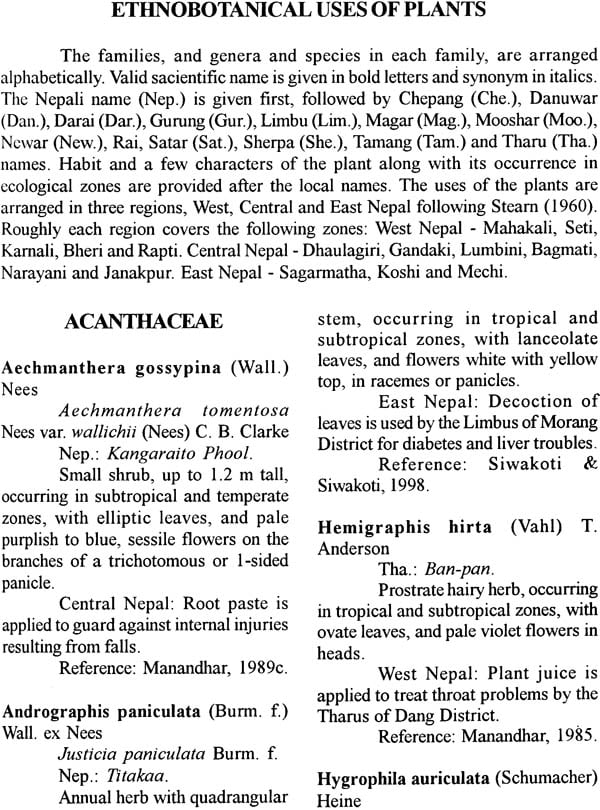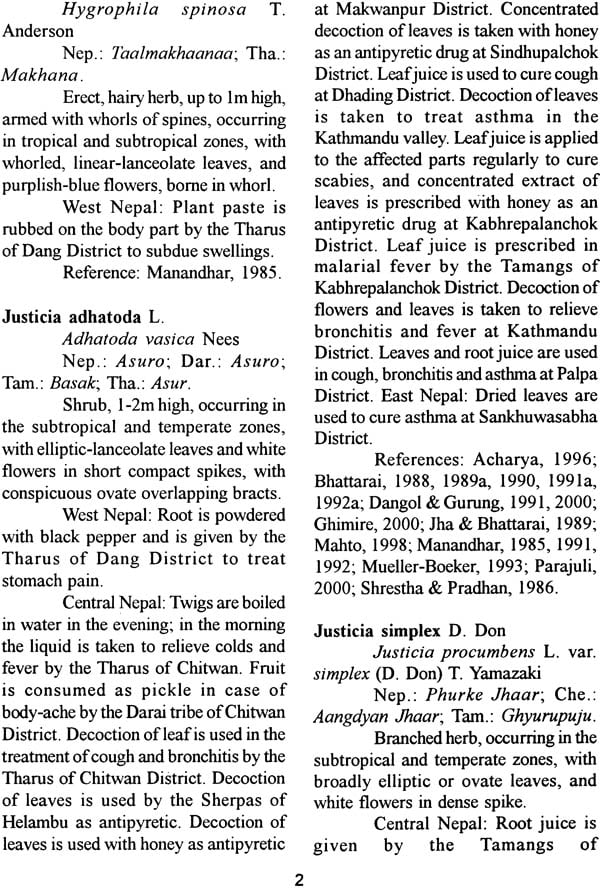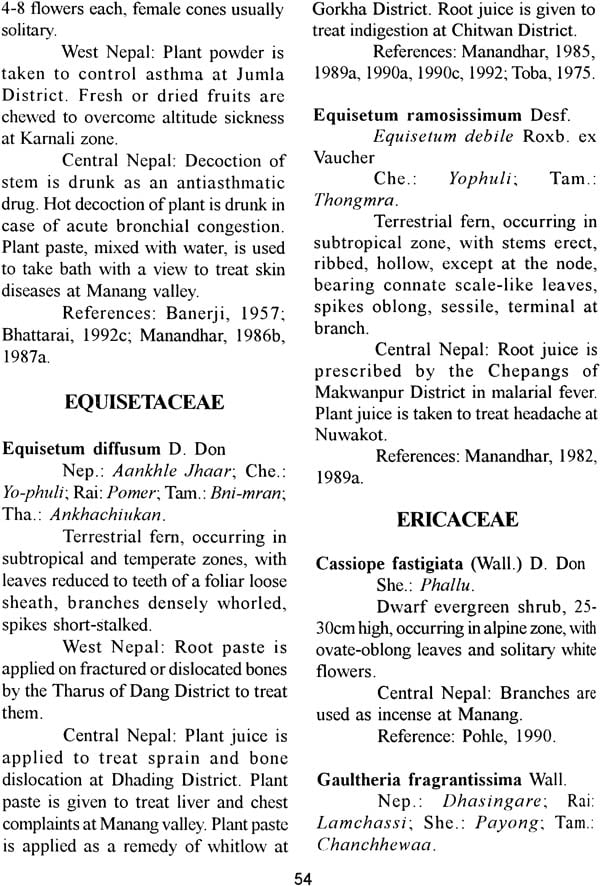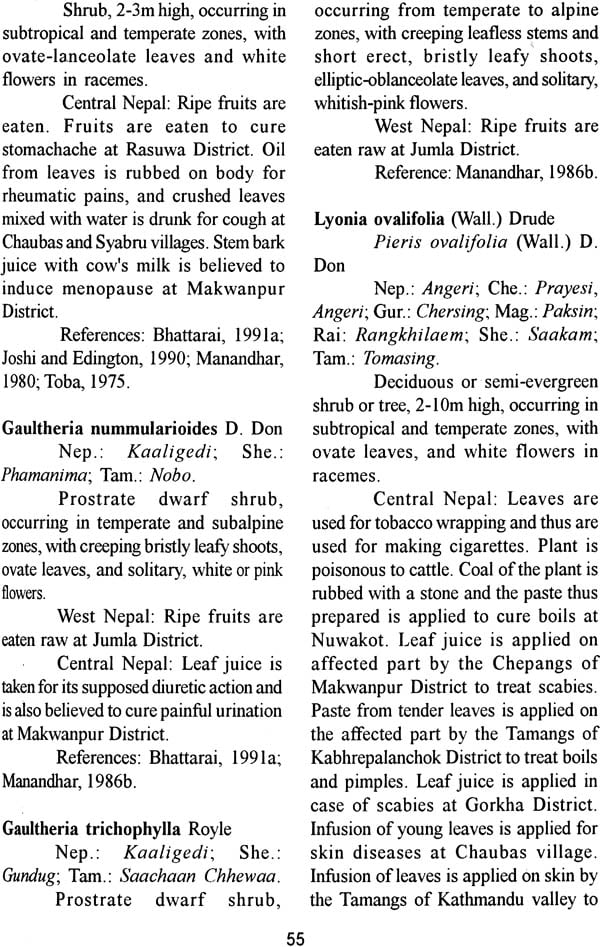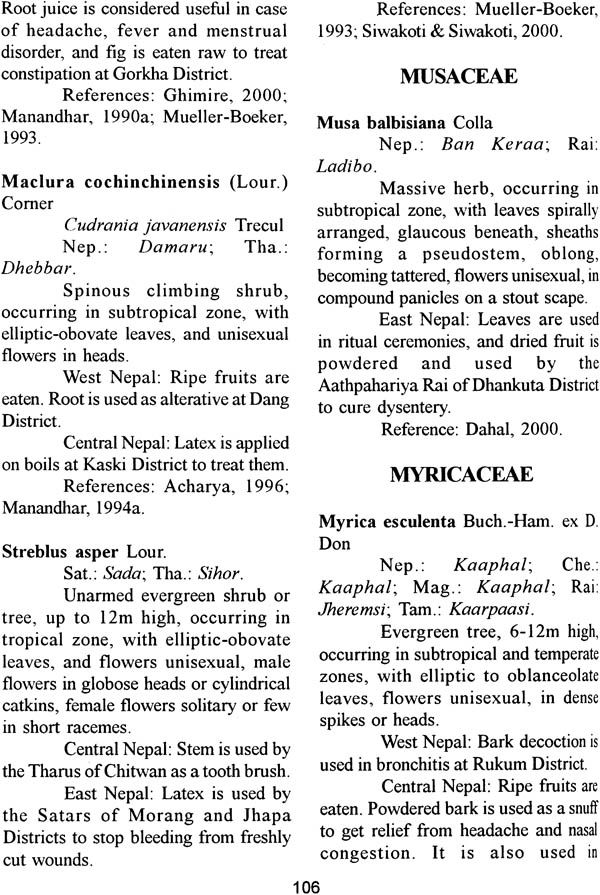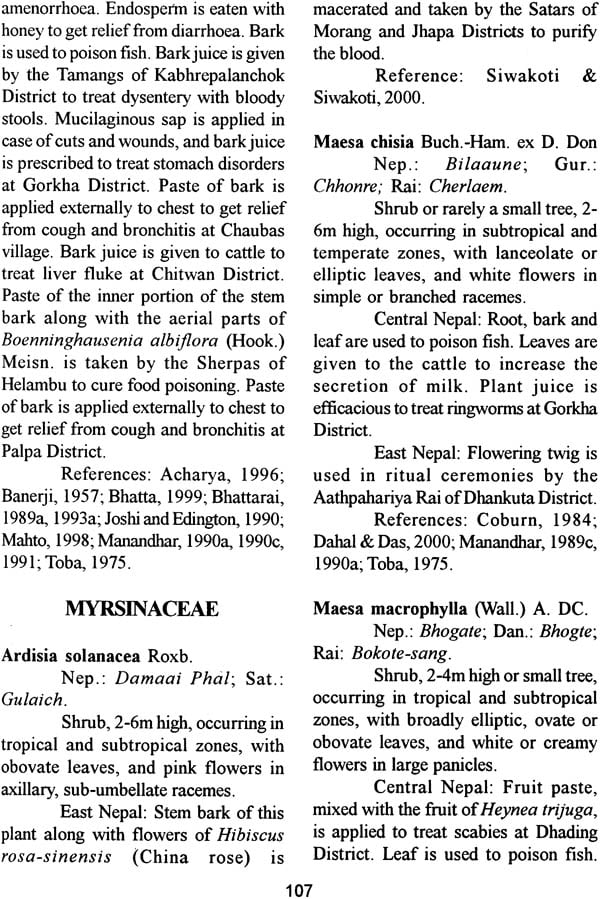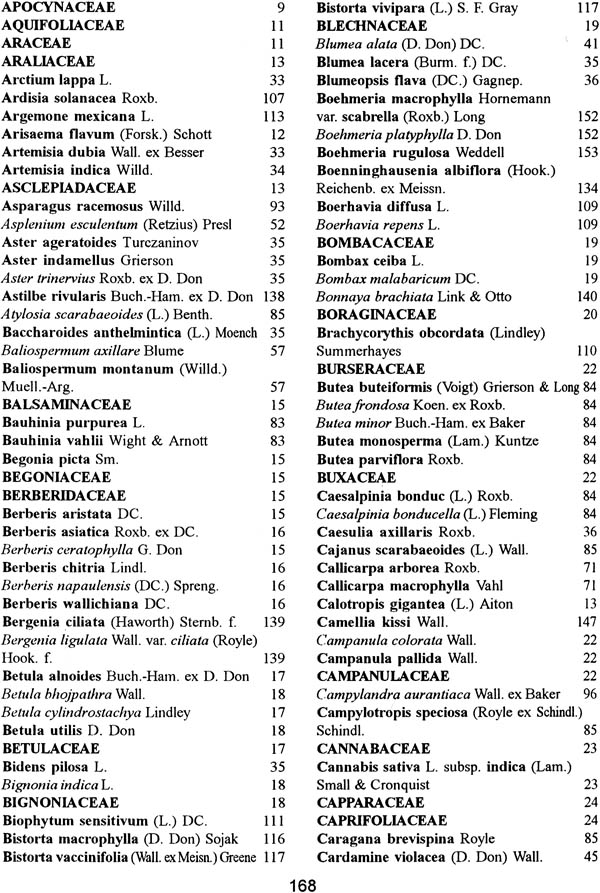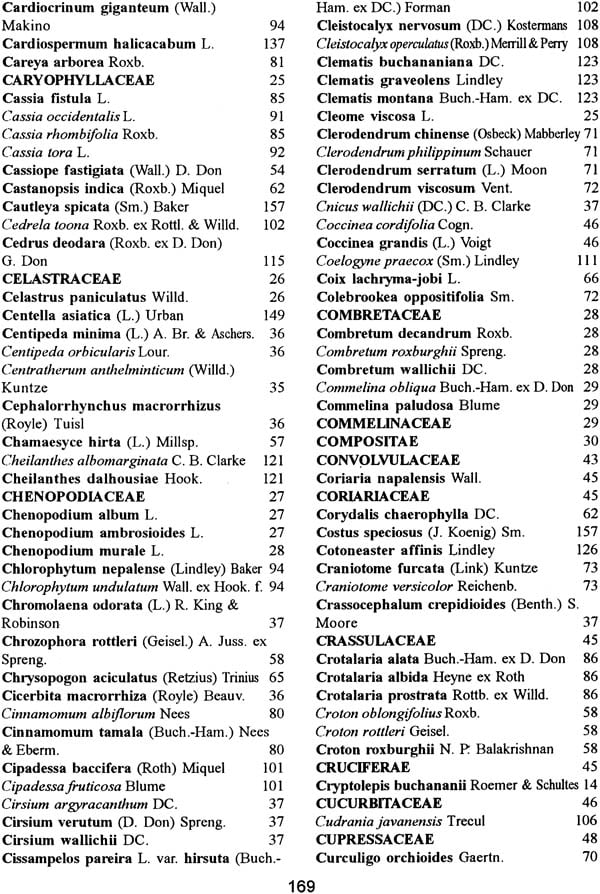
Ethnobotany of Nepal
Book Specification
| Item Code: | NAM728 |
| Author: | Keshab R. Rajbhandari |
| Publisher: | Ethnobotanical Society of Nepal |
| Language: | English |
| Edition: | 2001 |
| ISBN: | 9993334804 |
| Pages: | 202 |
| Cover: | Paperback |
| Other Details | 8.0 inch x 6.0 inch |
| Weight | 280 gm |
Book Description
Nepal is a land of great altitudinal and ethnic diversity. The altitudinal limit varies from less than 150m to more than 8000m above sea level. Due to this altitudinal variation tropical to alpine vegetation and more than 6000 species of vascular plants as well as many ethnic groups with different customs and languages are found in Nepal providing for a great opportunity for ethnobotanical study. This book, Ethnobotany of Nepal, enumerates 562 species of wild flowering plants and ferns of ethnobotanical values found in Nepal with their local names and uses. Among them 450 species carry medicinal properties, 125 species are edible and 70 species have miscellaneous uses. The families, and genera and species in each family, are arranged alphabetically. In each species available Nepali and other local names are given. Habit and some other characters of the plant are provided after the local names. Indexes of the scientific names and local: names are provided. The book will be useful for researchers, teachers and students of plant science as well as to the agriculturists, foresters, anthropologists and even environmentalists.
Keshab R. Rajbhandari
Keshab R. Rajbhandari is currently working as a Scientific Officer in the Department of Plant Resources, Kathmandu. He received Master of Science degree in botany from Tribhuvan University, Kathmandu, in 1972. He was awarded Doctor of Science in plant taxonomy from the University of Tokyo, Japan, in 1989. He has worked in Central Department of Botany, Tribhuvan University, from 1973 to 1974 as an Assistant Lecturer. He has widely travelled in Nepal in the pursuit of plant research. He is life member of the Society of Ethnobotanists, India (Fellow of the Society of Ethnobotanists) and the Ethnobotanical Society of Nepal.
Since last few decades, several papers on different aspects of Ethnobotany in Nepal are publishing at regular intervals, however, a comprehensive book on Ethnobotany is still lacking. To fulfill this gap, Dr. Keshab Rajbhandari, the Scientific Officer of Department of Plant Resources, has done a commendable effort to compile ethnobotanical information of Nepalese plants in the form of the present book 'Ethnobotany of Nepal'.
The book comprises the introduction with historical background, followed by the ethnobotanical uses of 562 species of plants, as used by various ethnic communities or tribes of Nepal. Each species is provided with current botanical name, important synonym(s), local names, brief description, and ethnobotanical uses with references. The plant names are arranged in an alphabetical order of family, genus, and species respectively. Moreover, the book is accompanied by index of scientific names, local names, and references as well. The ethnobotanical uses of the plants mentioned in this book are largely based on the published literature. The author has screened hundreds of literature to compile the book. Thus, I believe, the bulk of information provided in the book will be invaluable to the botanists, ethnobotanists, foresters, agriculturists, chemists, and pharmacologists, etc.
The curriculum of Botany in Tribhuvan University has been revised a couple of years before. An elective course on 'Ethnobotany' is now introduced at B. Sc. and M. Sc. levels. There are few excellent books on Ethnobotany namely, Ethnobotany: a methods manual (Martin, 1995), Ethnobotany. Principles and Applications (Cotton, 1996), and Applied Ethnobotany: people, wild plant use and conservation (Cunninghams, 2001), etc. Although these books are widely used as basic reference books, however, I believe, the present book 'Ethnobotany of Nepal' will serve as an important reference book on the ethnobotanical uses of the wild plants of Nepal.
The Ethnobotanical Society of Nepal (ESON) is grateful to the International Development Research Centre (IDRC), New Delhi and, in particular, Dr. Madhav Karki for providing financial support to cover the partial expense to publish the book. Finally, on behalf of ESON, once again I would like to express my heartfelt thanks to Dr. Rajbhandari for his valuable contribution and painstaking effort to bring out this book.
Nepal is a land of great altitudinal and ethnic diversity. The altitudinal limit varies from less than 150 m to more than 8000 m above sea level. Due to this altitudinal variation tropical to alpine vegetation and more than 6000 species of vascular plants are found in Nepal. People living from hot areas in the south to cold areas in the north are diversified into many ethnic groups with different customs and languages. With such diversities in vegetation, flora and ethnic groups Nepal provides a great opportunity for the ethnobotanical study.
Ethnobotany deals with the study of the relationship between people and plants and the documentation of indigenous knowledge on the utilisation of local plant resources by different ethnic groups or communities is one of the main objectives of ethnobotanical research. In connection with general plant collections carried out during the botanical expeditions by the scientists of the foreign institutions I had opportunities to study some of the plants utilised by the different ethnic groups of Nepal in various districts. Recently references on the ethnobotanical study of Nepalese plants are frequently appearing. These valuable information though scattered need to be recorded in a systematic way and disseminated for utilisation and conservation of plants. The main objective of this book is to record information on the plants used by some ethnic groups of Nepal for various purposes, such as food, medicine, and miscellaneous uses, based upon the information gathered from local people in different parts of Nepal through several years of field research and available published literature.
I am grateful to Dr. Saman Bahadur Rajbhandary (Academician, Royal Nepal Academy of Science and Technology and Ex Director General, HMG Department of Forestry and Plant Research) for providing a Foreword for this book. Thanks are due to Mr. Madhusudan Bista (Director General, Department of Plant Resources), Mr. Yogesh Vaidya (Deputy Director General, Department of Plant Resources), Dr. Samar Bahadur Malia (Ex Director General, Department of Medicinal Plants), Dr. Tarakeshari Rajbhandari (Ex Acting Director General, Department of Plant Resources), Dr. Tirtha Bahadur Shrestha, Dr. Pushpa Ratna Shakya, Dr. Narayan Prasad Manandhar, Dr. Pramod Kumar Jha, Dr. Ram Prasad Chaudhary, Dr. Narendra Nath Tiwari, Dr. Keshab Shrestha, Dr. Purushottam Shrestha, Dr. Dharma Raj Dangol, Mr. Dinesh Satyal, Dr. Nirmal Kumar Bhattarai, Dr. (Ms.) Sushila Bhattarai, Ms. Radha Joshi, Mr. Kuber Jang Malla, Mr. Bindeswor Roy, Mr. Suresh Kumar Ghimire and manv others, for fruitful discussion on the subject. Special thanks are due to Dr. Krishna Kumar Shrestha and Ms. Sangita Rajbhandary, President and Treasurer respectively of the Ethnobotanical Society of Nepal, for showing interest to publish this book.
In this book 562 species of wild flowering plants and ferns (538 species of Angiosperms, 12 species of Gymnosperms, and 12 species of Pteridophytes) are given with their local names and uses. The families, and genera and species in each family, are arranged alphabetically. In each species available Nepali name is given first, followed by other local names. Habit and some other characters of the plant are provided after the local names. Indexes of the scientific names and local names are provided. It is hoped that this information will help to increase the knowledge on the ethnobotanical field of Nepal and will be useful for researchers, teachers and students of plant science as well as to the agriculturists, foresters, anthropologists and even environmentalists.
Nepal extends along the Himalayan range between the latitudes of 26° 22' and 30° 27', and longitudes of 80° 04' and 88 12' E. The country has an area of 147,181 sq. km. About two-third of the area is occupied by hills and mountains, which rise from the Terai in the south. Altitude varies from less than 100 m in the south to the crest of the Himalaya reaching over 8,000 m in the north. It enjoys a monsoon type of climate with wet summer and dry winter. Maximum rainfall occurs during June to September. The eastern part of the country is wetter than the western part. Taplejung (1768 m altitude) in the far eastern mid-mountain district receives an annual average rainfall of 2024 mm while Baitadi (1635 m altitude) in the far west receives 1037 mm. Southern slope of the Himalayan mountain slope receives higher rainfall (3,477 mm in Pokhara) while Jomsom lying north of main Himalayan range receives 295 mm. Being a mountainous country the temperature varies proportionately with topographical variation. Maximum temperature in the lowland Terai reaches 43 degree centigrade. The temperature goes on decreasing with the rise in altitude. The minimum temperature reaches 14 degree below zero at Namche Bazar at 3450 m altitude.
Vegetation
In relation to climate tropical to alpine types of vegetation are found in Nepal. In the tropical zone (up to 1OOO m altitude) vegetation is dominated mostly by Shorea robusta (Sal) in association with Terminalia bellirica, Terminalia chebula, Terminalia alata, Phyllanthus emblica, Lagerstroemia parviflora, Cassia fistula, Haldina cordifolia, Syzygium spp. etc. and big lianas like Bauhinia vahlii, Butea parvijlora, etc. In places where the Sal trees are absent the associates form mixed forests. The subtropical zone (1000-2000m altitude) is represented by Schima wallichii-Castanopsis indica-Castanopsis tribuloides forest in the wet eastern part of the country and Pinus roxburghii forest in the western part. The major associates in the former are Engelhardtia spicata, Acer oblongum, Pyrus pashia, Eurya acuminata, Myrica esculenta, Comus oblonga, Persea duthiei, etc. In Pinus roxburghii forest the associates are less in number and kinds and are usually composed of Myrica esculenta, Lyonia ovalifolia, Quercus lanata, Rhododendron arboreum, etc. Quercus lanata on dry slope particularly in far western part of the country forms dominant forest in association with Rhododendron arboreum, Lyonia ovalifolia, etc. In the far humid east Castanopsis hystrix along with Castanopsis tribuloides takes the similar position. The temperate zone (2000-3000m altitude) is characterised by evergreen oaks, rhododendrons, conifers etc. with deciduous magnolias, maples, etc. Broad-leaved forests are predominant over coniferous one in the eastern and central parts. Broad-leaved species such as Quercus lamellosa, Quercus glauca, Daphniphyllum himalayense, various laurels, deciduous Magnolia campbellii, various maples, etc are conspicuous in the east and central Nepal. Broad-leaved forest of Lithocarpus pachyphylla is localized in the extreme east. Quercus dilatata, Aesculus indica, Juglans regia var. kamaonia, Acer sp. etc. are the species that dominate the broad-leaved forest in western Nepal. Pinus wallichiana, Picea smithiana, Cedrus deodara and Abies pindrow are the main conifers that dominate the conifer forest. Tsuga dumosa forms patches of forest in moist valley slopes. Similarly, Quercus semecarpifolia forms dominant forest in rather drier slopes. The associated trees of this forest are various laurels, Rhododendron arboreum, Lyonia ovalifolia, Corylus sp., Carpinus viminea, Taxus wallichiana, Betula alnoides, etc. The subalpine zone (3000-3600m altitude) is characterized by extensive Abies spectabilis forest in combination with the Himalayan birch, Betula utilis . The birch usually concentrates along water courses and forms pure forests, otherwise it forms the second layer of canopy along with rhododendrons under the fir. The usual associates in the forest are Acer caudatum, Acer pectinatum, Sorbus vestita, Sorb us microphylla, Sorb us foliolosa, Prunus spp. etc. Deciduous Himalayan larch, Larix himalaica forms forest in pockets in central Nepal but is now scatteredly present. Pure juniper forest composed of Juniperus pseudosabina is a feature of inner Himalayan valleys and dry southern aspect. The juniper extends well beyond tree line in the alpine zone. The plant height goes on decreasing with the increase of altitude forming a broad transition zone. It becomes bush and forms mats or cushions at higher altitude. The alpine zone (above 3600m altitude) is characterised by hardy perennials, which can withstand harsh and severe cold and the annuals, which complete their life-cycles within the short snowless period of the year. Rhododendron bushes usually dominate the shrubby vegetation. Other common shrubs include Potentilla rigida, Hippophae tibetana, Berberis spp., etc. Herbs are primroses, gentians, poppies, marsh marigolds, buttercups, etc. Loose scree vegetation is usually composed of cushion plants, composed of various species of Arenaria, Androsace, Allardia, Saxifraga, etc. The area above 5000 m is usually covered by permanent snow and ice. However, on the sunny rock edges and crevices free from snow and ice some hardy and extreme cold resistant cushion plants have been recorded.
Ethnobotanical explorations and studies in Nepal
Ethnobotany deals with the study of the relationship between people and plants and most commonly refers to the study of how people of a particular culture and region make use of indigenous plants. The term 'ethnobotany' was first used by Harsberger (1896) who defined it as the study of plants used by primitive and aboriginal people. Schultes (1962) defined ethnobotany as the study of relationship that exists between people of primitive societies and their plant environment. Ethnobotany, in totality, is virtually a new field of research. And, if this field is investigated thoroughly and systematically, it will yield results of great value to the ethnologists, archaeologists, anthropologists, plant-geographers, ethnobotanists, botanists, linguists and ultimately to pharmacologists and phytochemists (Shah, 1981). The main aim of ethnobotany is to document the knowledge about plants that had come through generations and use the knowledge for the benefit of the society. Its importance has been realized that it brings to light numerous less known or unknown uses of plants, some of which have potential wider usage (Chaudhary, 1998). Historically plants used in traditional medicine by the indigenous populations across the world have produced some of the most useful modem day pharmaceuticals. It is, therefore, very important that studies in Ethnobotany and Ethnophannacology continue if the preservation of traditional knowledge is the goal (R. S. Medora, 2001, Forewords in Joshi & Joshi, 2001). The science of ethnobotany has recently received much attention in certain parts of the world, particularly in the underdeveloped and/or developing countries, where small or large portions of populations still depend on natural resources in practically indigenous condition and the impact of modem systems of medicine has not reached them (Jain, 1981).
Nepal is a multiethnic and multilingual country. There are more than 60 different ethnic groups speaking about 75 languages in Nepal (Shrestha, K. K., 1998). Nepal thus provides a great opportunity for the ethnobotanical study (Rajbhandari, 1990, 1994b). Nepali people have been utilising the plants and plant products since time immemorial. Many people still do not have access to the modern medicinal facilities, and entirely depend on the plant resources. It is estimated that various communities in Nepal use approximately 1000 species of wild plants in traditional medicinal practice and majority of which await proper documentation (Chaudhary, 1998).
It is nearly a two-century-old history since the recorded botanical exploration and study started by foreign scientists in Nepal. It was also the start of the ethnobotanical exploration in Nepal. It was Francis Buchanan, a Scottish medical man, who first collected plant specimens in Nepal in 1802-3, and that was followed by Nathanial Wallich in 1820-21, who collected plant samples in and around Kathmandu valley (Rajbhandari, 1976). Their collections of plants with ethnobotanical notes are recorded by Don (1825) and Wallich (1824-1826).
A good information on the ethnobotanical and medicinal uses of the Nepalese plants can be found in the Chandra Nighantu, a herbal pharmacopoeia of medicinal value of plants, the manuscript of which was initiated by the then Prime Minister Bir Samsher Jung Bahadur Rana in the late 19th century to use and develop traditional medicine system based mainly on Ayurveda in Nepal. Late Pandit Kaviraj Shree Ghana Nath Devkota was assigned to prepare this Nighantu which was named as Bir Nighantu (Malla, 1999). This interesting and valuable document could not be completed during the regime of Bir Samsher. Later, Chandra Samsher, who succeeded him as Prime Minister, wanted to change its name into Chandra Nighantu after completion (Devkota, 1968). This is a hand-written herbal encyclopedia including about 840 colour plates, 750 of plants and 90 of animals, and over one thousand pages of their explanations. It consists of 10 volumes, of which 8 volumes are botanical, 1 zoological and another mineralogical (Kanai, 1971). Explanations, mainly of medicinal usage written in Sanskrit and Newar, are quoted from various classics. Vernacular names of Nepali, Newar, many languages of Indian tribes, Persian and Arabic, and sometimes of Tibetan, English and Latin are mentioned. This immense work shows the high level of Nepalese herbal science and is useful as excellent icons of Nepalese plants as well as a reference book of Ayurvedic science (Kanai, 1971).
Recently, information on ethnobotanical studies of various tribes and regions of Nepal is gradually accumulating. References on ethnobotanical literature dealing with Nepalese flora and local indigenous communities are recorded by Rajbhandari (l994a, 2001) and Shrestha, P. (1998). Studies carried out by N. P. Manandhar, N. K. Bhattarai, D. R. Dangol, K. Shrestha, P. Shrestha, M. Siwakoti, S. K. Ghimire, Ms. I. Shrestha and several other Nepalese botanists and foreign scientists and anthropologists, such as B. Coburn, U. Mueller-Boeker, P. Pohle, J. Sacherer, S. Toba, G. Toffin, have enriched the literature of ethnobotany of Nepal. The citations include writing that deals with ethnobotanical knowledge of different tribes and districts. The tribes studied are Chepang (Khan, 1998; Manandhar, 1989a), Danuwar (Manandhar, 1990b), Darai (Dangol & Gurung, 2000), Gurung (Coburn, 1984), Limbu (Siwakoti & Siwakoti, 1998), Mooshar (Manandhar, 1986a), Rai (Dahal, 2000; Dahal & Das, 2000; Toba, 1975), Raute (Manandhar, 1998), Satar (Siwakoti & Siwakoti, 2000; Siwakoti et al., 1997), Sherpa (Bhattarai, 1989a; Sacherer, 1979), Tamang (Manandhar, 1991; Shrestha, 1988, 1989a; Toffm & Wiart, 1985), and Tharu (Dangol & Gurung, 1991; Ghirnire, 2000; Mueller-Boeker, 1993, 1999). The districts covered include various geographical regions. They are: Baglung (Manandhar, 1993a), Bara (Amatya, 1996), Chitwan (Dangol & Gurung, 1991, 2000; Khan, 1998; Manandhar, 1990c; Mueller-Boeker, 1993, 1999), Dadeldhura (Manandhar, 1998), Dhading (Manandhar, 1992), Dang (Acharya, 1996, Manandhar, 1985), Dhankuta (Dahal, 2000; Dahal & Das, 2000), Dhanusha (Manandhar, 1986a), Dolakha (Bhattarai, 1993b; Sacherer, 1979), Dolpa (Ghimire et al., 2001), Gorkha (Manandhar, 1990a), Jajarkot (Manandhar, 1995d), Jumla (Manandhar, 1986b), Kabhrepalanchok (Bhattarai, 1990; Manandhar, 1991), Kaski (Manandhar, 1994a; Shrestha, P. 2000), Kathmandu (Bhattarai, 1988; Jha & Bhattarai, 1989; Shrestha, 1988, 1989a; Shrestha & Pradhan, 1986), Lalitpur (Shrestha & Joshi, 1993), Lamjung (Manandhar, 1987b), Makwanpur (Bhattarai, 1991a; Manandhar, 1989a, 1995a), Manang (Manandhar, 1987a; Pohle, 1990), Morang (Siwakoti & Siwakoti, 1998), Myagdi (Manandhar, 1995b), Nawalparasi (Ghimire, 2000), Nuwakot (Manandhar, 1982), Palpa (Mahto, 1998; Shrestha, 1985), Parsa (Yadav, 2000), Rasuwa (Manandhar, 1980), Rukum (Bhatta, 1999), Sankhuwasabha (Parajuli, 2000), Sindhuli (Manandhar, 1990b), Sindhupalchok (Bhattarai, 1989a, 1992a; Shrestha, 1989b), Sunsari (Shrestha, K., 2000), and Surkhet (Manandhar, 1993c). Besides these, ethnobotanical study ofthe Churiya of eastern Nepal has also been carried out (Oli et al., 2000). The references on ethnobotanical studies of central Nepal (Bhattarai, 1991b, 1992b, 1992d, 1993a, 1993d, 1994), Central Development Region (Joshi & Edington, 1990; manandhar, 1989c), Rapti Zone (Bhattarai, 1993c), food plants (Manandhar, 1993d, 1995c), ferns (Manandhar, 1996), piscicidal plants of Nepal (Manandhar, 1989d), Lake Phewa and Lake Rupa (Shrestha, 2000) are also available. The importance of ethnobotany has been increasing considerably and even international organization such as World Wide Fund for Nature (WWF) Programme has considered this to be an essential part of the programme (Cunningham, 2001; Martin, 1995). In Nepal also since June 1997, an applied ethnobotanical project has been undertaken by the People and Plants Initiative of the WWF in collaboration with WWF Nepal Programme in Shey Phoksundo National Park and its buffer zone. The first year of the project (1997) has addressed the issues concerning ethnobotany, local health care and ecological status of medicinal and aromatic plants. Considering the recommendations of the first year, the project has focused on two targets in the second and third year (1998 and 1999): (I) developing a community based-management of medicinal plants in the Pungmo area of Phoksundo VDC (Village Development Committee), and (II) improving local health care through building the capacities of amchis (traditional Tibetan doctors) and women (Ghimire et al., 2000). The ethnobotanical surveys revealed a rich local knowledge about the medicinal plant resources and their management (Ghimire et al., 2000). Implemented within the larger framework of the People and Plants' Initiative, UNESCO and ICIMOD (International Centre for Integrated Mountain Development), as a joint operation, launched an applied ethnobotany project from 1995 to 1998 in the Hindu Kush - Himalayan region aimed to build up capacities of and capabilities in institutions, improve the skills of young ethnobotanists, and bring ethnobotany into the mainstream in integrated conservation and development research (Rastogi, 1999). Summaries of the following five case studies carried out under this project in Nepal are presented by Rastogi (1999): (a) 'Application of indigenous knowledge of fodder trees in Kalikasthan, Rasuwa District' studied by S. Acharya and guided by N. P. Manandhar; (b) 'Investigation of the status of indigenous medicinal plants and their conservation in the Newar community: A case of Bungamati VDC, Lalitpur, Nepal' studied by Ms. M. Pokhrel and Ms. R. Shrestha under the guidance of R. K. Sharma; (c) 'Genetic diversity, distribution pattern, germination and ethnobotanical uses of Alnus nepalensis and A. nitida in Lumle and the Pokhara region of Gandaki Zone, Nepal' studied by B. Sah and supervised by B. N. Prasad; (d) 'Community-based case study on Sal (Shorea robusta) forest menagement and Sal seed collection for commercial potential' studied at Makwanpur by Ms. S. Rajbhandary in association with V. K. Kama and N. Dongol; (e) 'Ethnomedicobotanical studies ofGurung communities in Bichaur Village, Lamjung, Nepal' studied by Ms. I. Shrestha and Ms. P. S. Tuladhar (Pers. Comm. D. R. Dangol, 2001).
| Foreword | |
| Foreword | |
| Preface | |
| Introduction | ix |
| Ethnobotanical uses | 1 |
| References | 159 |
| Index of scientific names | 167 |
| Index of local names | 179 |
